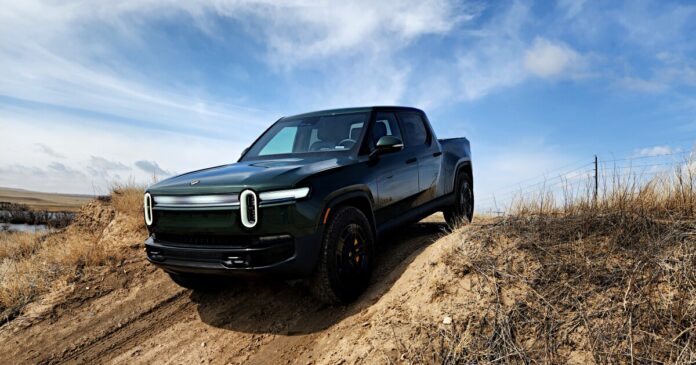The Rivian R1T is a pickup truck, yes. But it also is not. The Rivian is more a product of Silicon Valley than of Detroit, which is why it’s so unique. For some, it will be like listening to a hipster explain his kombucha recipe. But for others, it’s a refreshing take on a truck.
At a glanceDesign is both basic and uniqueApps and screens dominateFive motor/battery combinations, two trim levelsPrice tag is not for the proles
Like most pickup trucks, the Rivian R1T has a basic four-door, short-bed design. There are two sport seats up front and a bench in the back, for a total of five seating positions. The cargo bed has a tailgate that allows access and extension. The chassis is rear-wheel-drive-centric, and the truck rides relatively high off the ground with strong framing for towing and hauling. All basic pickup stuff.
Those things are expected in any truck, and are the features that Detroit makes will highlight when showing their trucks at locations such as construction sites and lumber yards. You will not see a Rivian in those kinds of places, however. Because outside of those basics, the R1T departs from the standard truck motif in a lot of ways. Most of which are either genius ideas or weird quirks, depending on your point of view.
First, there’s the look of it. Rivian plays with rounded edges, smooth corners, small, oddly-shaped headlights, and a general kind of futuristic but not alien design. You’re expected to know that the R1T is a pickup, but you’re not expected to assume it’s like the other trucks. It looks new enough to be refreshing, but not so out of place that it’s … well, a Cybertruck, I guess.
A couple of things common to electric pickup trucks are present on the R1T: a big frunk, all-wheel drive by default, stupidly fast acceleration, and air ride suspension. The latter is a common thing because EVs in general are heavy, and EV trucks are HEAVY in capital letters. Most are in the over-7,000-lb (3,175-kg) club, which is about 40% heavier than a gasoline pickup like the Ford F-150. The frunk is not ergonomic like others, however, as the hood is a cap on top rather than opening with the grille like the trunk of a car. This makes access to the frunk’s tub less than ideal.
The R1T’s biggest out-of-box idea is the central “gear tunnel” storage. Doors on either side of the truck, ahead of the rear wheels and behind the cabin, open to allow access to a substantial storage tunnel. They open down, however, so they’re right where your legs want to be while loading things into the tunnel.
That said, the doors become platforms that can bear about 250 lb (113 kg), and provide a step up to the front portion of the cargo bed. But they feel flimsy, and I was never able to trust them with that kind of weight bearing. The gear tunnel can also be accessed via the rear seats’ fold-down armrest, similar to the ski pass-through in many European sedans. But seeing the camp kitchen and other ideas for this gear tunnel makes it a suddenly mind-boggling option for imaginative uses.
More interesting departures from standard pickup design are found in the R1T’s cargo bed.
The spare tire for the Rivian, for example, is placed under the bed. A portion of the bed is latched and hinged, allowing it to lift to access the spare. There are pros and cons to this approach, the pros being that the spare and tools are not exposed to the elements and the resulting rust and junk that accumulates when the spare is slung underneath the truck. The cons include the fact that anything in the truck bed has to be removed in order to access that spare. Some might also find that removing the spare creates another hidden, lockable storage space on the truck.
Another unique idea in the R1T’s cargo bed is a seamless tailgate. Most truck tailgates create a large crevasse or seam between the tailgate and the bed floor when the tailgate is down for loading or unloading. Rivian removed that seam with an integrated, sliding cover piece that automatically bridges that gap to create a smooth loading floor. It’s one of those genius touches that you don’t know you need until you experience it, and then it becomes a must-have. It’s similar to the dual-hinged tailgate of the Honda Ridgeline or the dual-opening tailgate on a Ram Truck.
Rivian, like Tesla, also went all-in on screens and apps. There aren’t very many buttons or switches inside the R1T. Those functions are instead controlled with a big touchscreen. The interface is unique and requires some time to learn. Pressing the truck icon, for example, pops up a menu for locking and unlocking doors, unlatching the panels for the gear tunnel, opening the frunk, changing the shading for the glass roof, etc. Next to that, the driver’s name (detected via the app or key card) allows adjustment of various things like mirrors and the head-up display.
Those adjustments are made with the only buttons on the steering wheel, a right and left set of left-right buttons and a spinning wheel. Those same steering wheel controls will do other things, depending on what the infotainment screen has activated. Volume and channel controls for audio, choosing drive modes, raising and lowering the air suspension, and more.
The Rivian app gives the user access to a lot of functions both in and outside of the vehicle. Most of the above-mentioned things are there plus climate settings (and pre-settings), charge controls/status, and such. Your phone (with the app) can also act as the vehicle’s key. Unfortunately, the app is finicky. At least for some. It didn’t work the entire week I had the R1T in my driveway. It worked fine for a friend’s phone. Both are Android units. It also worked fine for another journalist who drove the same truck earlier using an iPhone. And users online frequently complain about the app crashing or not logging in at inopportune times.
There are some downsides to a company and its product being new. The large number of recalls and consumer complaints for both the R1T and the R1S (Rivian’s SUV) are part of the growing pains faced by newcomers to the automotive industry.
The 2025 Rivian R1T comes with three battery options and four drivetrain choices. As expected, the battery pack size option generally coincides with a drivetrain choice. Naming conventions for these configurations denote motor count and battery pack size. So the base model, the Dual Standard, uses the smallest pack, while the Dual Large upgrades to a larger battery. An option for the Max battery pack is available as the Dual Max.
The Tri Max and Quad Max models are three- and four-motor designs using the biggest battery. I drove the Tri Max, which has an EPA estimated range of about 371 miles (597 km). Range estimates will vary depending on battery size, with the lowest range being the 270-mile (434-km) Dual Standard and the highest being the 420-mile (676-km) Dual Large.
If that feels confusing, you’ll be relieved to know that Rivian only has two trim levels for the R1T beyond those powertrain choices. All of the Dual-labeled models are in the Adventure trim level. The Ascend trim is for the other two powertrain options (Tri and Quad). Most of the additions to this trim are options on the Adventure trim. Including a retracting tonneau bed cover, an upgraded Dolby Atmos audio system, electronic glass roof, and so forth. It’s unclear why Rivian bothered having trim levels since they’re tied directly to motor choice. It’s probably a marketing thing to allow for trim equipment expansion later.
Power and speed are often mentioned when talking about electric vehicles. With trucks, speed is kind of pointless, but it’s still a thing. I’m not sure why pickup owners would care about acceleration speeds, given that a truck by design is possibly the worst drag racing option available.
At any rate, the Rivian R1T is stupid fast. So if you need your groceries to time travel or your home improvement store lumber to experience astronaut-level G forces, then you’ll be happy to know that the R1T can go from zero to sixty in about three seconds. That’s a full second faster than the F-150 Lightning and dual-motor Cybertruck. I give the comparisons because the real reason for these sprint times is to brag. Nobody who owns any of these trucks will actually achieve those times in the real world.
Speaking of the real world, it’s one thing to look at the R1T on paper and quite another to actually use it. It’s comfortable most of the time, with a good ride quality that I’d compare to any midsize pickup on the market. It’s not as refined as many of today’s full-sized trucks, though. Those are products of decades of refinement and movement from being utility vehicles to cushy daily drivers. The R1T is somewhere in the middle, way better than the bumpy and loud utilitarian trucks of the 80s, but not as smooth as the near-luxury pickups of today. I happened to like that quality about it, as it reminds you that you’re in a truck and not just another family hauler.
The Tri model is also an exceptional off-road go-getter. More so than I’d expected. Off-road settings are found, of course, in the infotainment screen. Settings are relatively basic, with pre-sets for general all-terrain, rock crawling, soft sand or dirt, rally speed, and dirt drifting (That one is fun). I stuck with A/T and sand most of the time, given what’s around me here in Wyoming.
The R1T also has more cameras than the NSA. At least, that’s what it feels like. The usual 360-degree array is there, but they’re augmented with other views popping up at convenient times, such as the left-hand camera activating when the left turn signal is used. The Rivian is already a relatively small and easy-to-maneuver truck, but the crystal-clear cameras and their high-res screens make the R1T even easier to off-road and park. My wife – who is a nervous driver and definitely not a truck enthusiast – loved the way the Rivian felt, thanks in no small part to these camera views.
My test model Rivian R1T didn’t include a tow kit, so I wasn’t able to test that. But to be frank, none of the electric trucks on the market are really good at towing. Not because they can’t hitch up large loads and pull them smoothly, but because once you attach that large load, your range drops to about a third. It doesn’t matter the make or model, range while towing will be less than half the truck’s EPA estimate – and that’s on a really good day with optimal conditions.
The 2025 Rivian R1T does have another problem endemic to EV trucks: price. The base model begins at about US$70,000. Most buyers will be closer to or over the six-figure range, though. My Tri Motor test model rang in at over $100,000 in all. Compared to other options in EV pickups, however, the Rivian isn’t too outlandishly priced. And trucks in general are now some of the priciest options in the automotive market.
My overall feel is that of the EV trucks I’ve driven so far, the Rivian is by far my favorite. It’s quirky, different, and a good rethink of what a pickup can be. It appeals to my outdoorsy and techy sides pretty well and has a sort of upscale Subaru vibe overall.
Product page: 2025 Rivian R1T


